
table of contents
- Heyday
- Flowering period: February
- Flowering period: March
- Flowering time: April
- Flowering period: May
- Flowering period: June
- Flowering period: July
- Flowering period: November
In creative garden design, blooming trees are superior to short-lived fads. Their lavish blooms harmonize with every style from baroque-romantic and noble-modern to Asian-minimalist. For every garden size and almost all lighting conditions there is the ideal tree as a floral guide. Browse through a handpicked selection of 30 trees, sorted by color and flowering time, with tips on the right location.
Heyday
Flowering times - the local framework conditions decide
The information on the flowering time of a tree is based on the assumption that normal, central European weather conditions dominate. If the weather is capricious, such as late night frosts or extreme drought, most trees postpone their flowering period to a later point in time. In the worst case, the flower fails completely because the buds have frozen to death. The following overview is sorted according to the usual beginning of the longed-for flowering period and indicates until when the bloom usually lasts. Furthermore, the assignment of the flower color relates to the hue that dominates at the zenith of the flowering period. Different tree species sprout in different color nuances or change their flower color towards the end of the season. Where this applies, you will find a corresponding reference to this variance.
Flowering period: February
Flower color: greenish
Corkscrew hazel (Corylus avellana 'Contorta')
The cultivar of the common hazel provides convincing evidence that a greenish flower color does not have to be boring. It is the special shape of the cat's blossom that qualifies the hazelnut tree for this selection. When February is stingy with colorful flowers in the garden, the ornamental tree with its male catkins and spherical female flowers on twisted branches sets pretty accents.
- Growth height: 400 to 600 cm
- Location: sunny to partially shaded

Flowering period: March
Flower color: White
Copper rock pear, rock pear (Amelanchier lamarckii)
With a frenzy of flowers in pure white, the rock pear enchants the garden in spring. From a distance, the umbrella-shaped crown looks like it has put on a floral bridal veil. The star blossoms transform into tasty, small fruits by late summer. The summer green foliage also contributes to the play of colors by taking on a decorative autumn color.
- Height: 300 to 400 cm
- Location: sunny to partially shaded

Flower color: Red
Hazelnut 'Rotblättrige Zellernut' (Corylus avellana)
Red spots of color are few and far between in early spring. How good that there is the 'Rotblättrige Zellernuss' that spoils us with red kitten flowers. At the same time, the red-brown buds of the leaves shine on the branches, which creates impressive accents. The dark red foliage only turns green in the course of summer. The neat color ensemble is followed later in the year by light brown, reddish shimmering hazelnuts, which are ready to be harvested from September.
- Height: 300 to 600 cm
- Location: sunny to partially shaded

Flower color: yellow
Cornelian cherry (Cornus mas)
The Cornelian cherry only emerges as a flowering tree at an advanced age. The waiting time until then makes the native flowering wood as a shapely shrub tasty with an opulent, yellow spring blossom that smells seductively. In mild locations, the sturdy fruit tree surprises with its golden-yellow flowers as early as February, which turn into red berries in late summer.
- Height: 300 to 500 cm
- Location: sunny to partially shaded

Flowering time: April
Flower color: White
Snowdrop tree (Halesia monticola)
The name says it all, because the graceful flowers look very similar to the onion flowers. Long before the leaves shoot, the starting shot for the romantic flowering time is given, which lasts until the end of May in mild spring weather. The elegant tree sheds its leaves before winter, but the pretty fruits adorn the crown until well into the next year.
- Height: 600 to 1200 cm
- Location: sunny, warm and protected
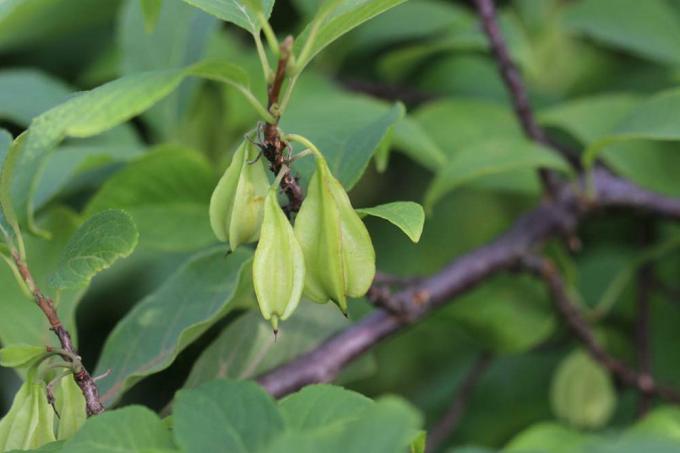
Real almond tree (Prunus dulcis)
A real almond tree should not be missing in the planting plan for the Mediterranean garden. After all, it is good frost-resistant within winter hardiness zones 7 and 8. In cooler regions, it trumps in the bucket with its white flowers, which are decorated with a red spot in the center. The 'Supernova' and 'Tuono' varieties carry crunchy almonds without the need for a pollinator variety.
- Height: 300 to 500 cm
- Location: sunny, warm and protected

Hanging wild pear, willow-leaved pear (Pyrus salicifolia 'Pendula ‘)
The willow pear is a hit among flowering trees for gardens with limited space. The branches with silvery leaves hang down picturesquely. From April to May the white flower panicles sprout in large numbers and complete the perfect performance. Thanks to the leisurely growth and robust cut tolerance, the care of the Mediterranean ornamental wood is designed without horticultural stumbling blocks.
- Growth height: 400 to 600 cm
- Location: full sun

Pear quince 'Cydora robusta' (Cydonia)
In April and May, the pear quince heralds the coming harvest of elongated yellow fruits with large, white peel blossoms. The quinces are not suitable for fresh consumption. The knowledgeable housewife knows how to conjure up a delicious compote or spread from the harvest. If you socialize pear quince and apple quince, both trees benefit each other in terms of flower yield and harvest yield.
- Height: 350 to 550 cm
- Location: full sun
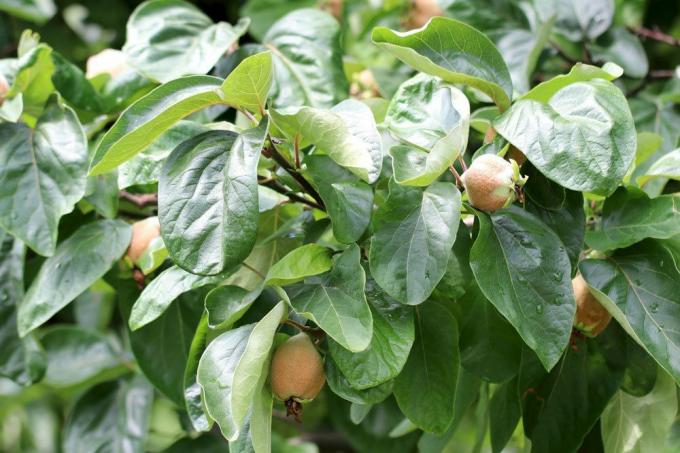
Bird cherry (Prunus padus)
Blooming trees that tolerate shade are few and far between in the plant kingdom. The bird cherry is one of the few weak light specialists that adorn its crown with white flowers in April and May. In autumn, small black berries ripen as a fruit decoration and a valuable source of food for birds. The native wild wood is reliably hardy and also thrives in problematic, damp and cold soils.
- Growth height: 600 to 1000 cm
- Location: sunny to shady

Tip: Spring-blooming trees usually set their buds in the previous year. The scissors should therefore be used very cautiously. The best time to cut is immediately after the flowering period has ended. In late winter, pruning is limited to a thorough thinning of the crown.
Flower color: pink
Tulip magnolia (Magnolia soulangiana)
We cannot ignore its floral charm when the huge purple-pink-white, tulip-shaped flowers appear in April. By the time the deciduous leaves flourish, the flowering period is almost over. If you want a longer flowering time, associate the tulip magnolia with the white flowering magnolia 'Wildcat', which blooms as early as the beginning of April, as well as the later blooming variety 'Heaven Scent', which blooms in May applies.
- Height: 250 to 450 cm
- Location: sunny and sheltered
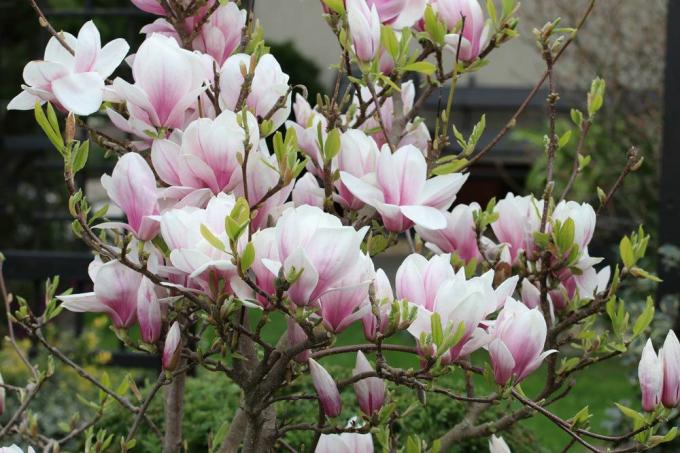
Blood plum 'Nigra' (Prunus cerasifera)
This little tree in the garden heralds spring with a festival of colors. From April the brown-red to black branches are covered with pink flowers. At the same time, the dark red decorative leaves sprout from the rounded crown. The small, red, edible fruits ripen in August and September, while the autumn leaves turn brown to dark red.
- Height: 300 to 400 cm
- Location: sunny to partially shaded

Mountain cherry, scarlet cherry (Prunus sargentii)
With a legendary blossom yield, the mountain cherry consoles over its unpalatable fruits. When the flowers bloom in April, the pink flowers contrast wonderfully with the bronze-colored shoots of the leaves. In the winter, the tree says goodbye with splendidly colored leaves in orange to scarlet red. The shiny, dark red cherries are nice to look at, but have an unpleasant bitter taste.
- Growth height: 600 to 1000 cm
- Location: sunny to partially shaded

Peach 'Red Haven' (Prunus persica)
The cosmopolitan among the flowering trees with fruity fruit is this peach tree with pink flowers in April. It can be found all over the world as an ornamental and fruit tree. If your garden is blessed with busy insects, in late summer the wood bears rich foliage of yellow-red fruits with soft pulp. Although the variety is considered self-fertile, if you socialize two specimens or combine the 'South Haven' variety, the abundance of flowers and the crop yield increase.
- Height: 200 to 400 cm
- Location: sunny to partially shaded

Canadian Judas Tree (Cercis canadensis 'Lavender Twist')
Behind its exotic appearance, the Judas tree hides a robust winter hardiness of up to - 25 degrees Celsius. Even a harsh winter cannot affect the pink-purple fairytale bloom in April. Interestingly, the flowers arise directly from the branches. In addition, the distinctive heart leaves keep their red color until autumn, when they sprout on the casually hanging branches.
- Height: 200 to 400 cm
- Location: sunny

Flower color: Red
Indian banana 'Sunflower', Paupau (Asimina triloba)
Gardeners with a weakness for exotic trees include the Indian banana in the imaginative design plan. The name of the plant is a bit misleading, because the Indian banana has nothing in common with the tropical banana. Rather, the tree thrives with a pyramidal or broad-oval foliage crown, up to 30 cm long leaves and brown-red to purple flowers in April and May. In warm, protected locations, nutritious fruits thrive on the condition of 160 frost-free days and 16 to 20 days with temperatures below freezing point.
- Height: 300 to 500 cm
- Location: partially shaded (in the first 3-5 years), sunny (older specimens)

Flowering period: May
Flower color: White
Handkerchief tree (Davidia involucrata vilmoriniana)
Are you looking for a spectacular flowering tree for your garden or large front yard? Then you can't get past the handkerchief tree. The more than 10 cm large, creamy white petals suggest white handkerchiefs fluttering in the wind. The furious flowering season extends well into June, underlined by heart-shaped to broadly egg-shaped, deciduous leaves.
- Height: 600 to 800 cm
- Location: sunny to partially shaded and well protected

Rowanberry (Sorbus aucuparia)
Pure white flowers with up to 10 cm large, simple flowers in spring time are not the only decorative attribute of rowan berries. By autumn, the withered flowers will turn into bright red berries, which your feathered gardeners will appreciate. In the winter, the deciduous tree says goodbye with a furious foliage color.
- Height: 600 to 1200 cm
- Location: sunny to partially shaded
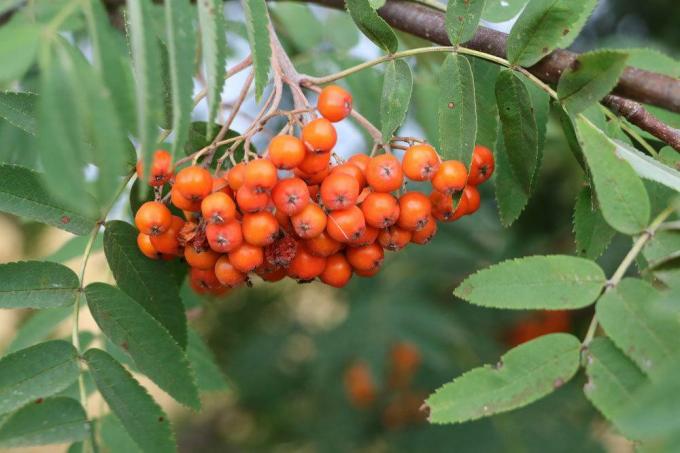
Crabapple (malus)
Ornamental apples are highly valued in the home garden due to their lavish flowering time in May and uncomplicated care. The numerous white bowl flowers are tinged with pink, which gives the tree a special magic. The premium variety 'Red Sentinel' found its way into our gardens from New Zealand because its cherry-sized, red apples decorate the autumn and winter garden with colorful colors.
- Growth height: 400 to 500 cm
- Location: sunny to partially shaded

Flower ash, ornamental ash (Fraxinus ornus)
A special piece of jewelery within the ash species immigrated to us from southern Europe. The flower ash takes its name from the fragrant, white flowers that last from May to June. In mild locations, the flowering time can start as early as April, much to the delight of bees, bumblebees and butterflies. The distinctive, deciduous pinnate leaves, which take on a bright yellow hue in autumn before they are thrown off, are also decorative.
- Growth height: 800 to 1000 cm
- Location: sunny to partially shaded
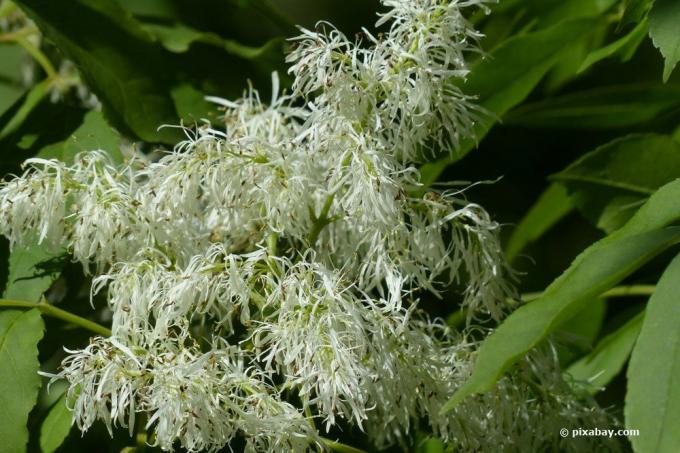
Flower color: Red
Autumn apple 'Elise Rathke' (Malus)
Picturesque apple blossoms are not limited to a white color scheme. This historic autumn apple from 1880 inspires with red flowers on elegantly drooping branches. The yellowish fruits are reddish in color on the sunny side and taste fruity-tart.
- Height: 200 to 400 cm
- Location: sunny to partially shaded
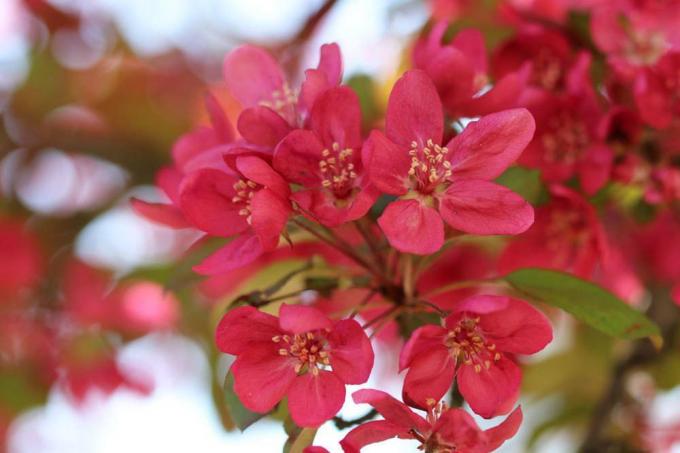
Flower color: blue
Bluebell tree (Paulownia tomentosa)
Blue flowers in the spring garden are not reserved for flowers and perennials. The bluebell tree from the Mediterranean region also gives you flowers in this noble and rare color shade. Huge, heart-shaped leaves stylishly round off the exotic habit. If your garden is in a mild wine-growing region or on the Lower Rhine, you can plant the tree out. In cooler climates, it is worth cultivating in a bucket with frost-free overwintering in order to enjoy the blue spring blossoms.
- Growth height: 800 to 1000 cm
- Location: sunny, in winter up to - 15 degrees Celsius

Flower color: yellow
Tulip tree (Liriodendron tulipifera)
If you are in the mood for a blooming tree with extravagant flower shapes, you are well advised with the tulip tree. The North American ornamental wood gives you an aesthetic experience of the special class with 10 cm large, yellow flowers and lobed ornamental leaves. The most important prerequisite for vital growth is enough space, because the tulip tree not only thrives quickly, but also expansively with a width of up to 2000 cm.
- Height: 2000 to 3500 cm
- Location: sunny, warm and protected
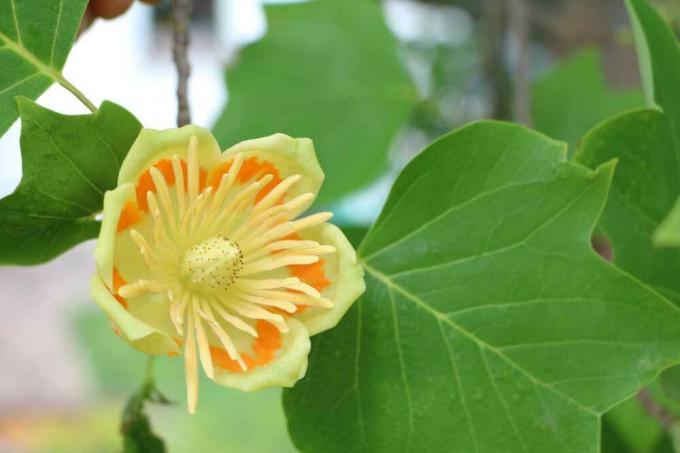
Flowering period: June
Flower color: White
Trumpet Tree (Catalpa bignonioides)
The high level of awareness of the non-blooming ball trumpet tree 'Nana' has pushed the wonderful properties of the majestic trumpet tree out of consciousness. Thanks to its enchanting, white bell-shaped blossoms with a yellow-striped throat, the pure species should not be missing in this selection. The flower show lasts until mid / end of July with large, heart-shaped leaves as a green passe-partout.
- Growth height: 1000 to 1500 cm
- Location: sunny to partially shaded
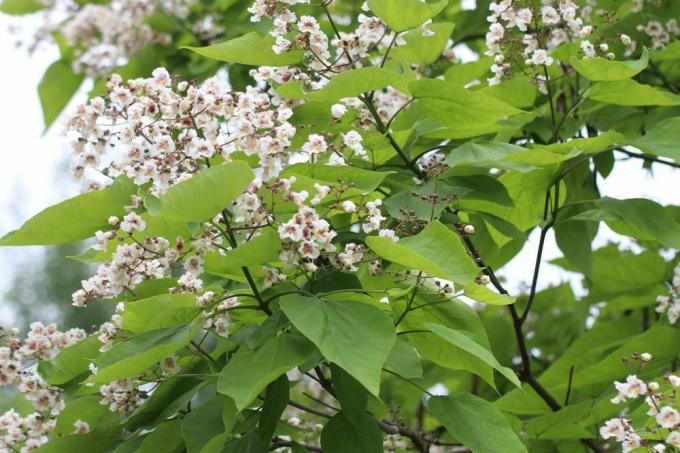
American yellowwood (Cladrastis lutea)
This flowering plant is characterized by fragrant white flower clusters over light green pinnate leaves on yellow shoots. The short-stemmed and multi-shoot tree is very popular in natural gardens because it is a valuable source of food for insects. In autumn, 6 to 8 cm long pods dangle in the crown, filled with a few seeds. In a warm, sheltered place, the butterfly bravely bravely defies winter hardships.
- Growth height: 600 to 1000 cm
- Location: sunny to partially shaded
Tall white dogwood, pagoda dogwood (Cornus controversa 'Variegata')
While other dogwoods thrive as flowering bushes with many shoots, the high dogwood stands out as a small, flowering tree. Its branches are arranged in tiers, dotted with white flowers in June. At the end of the flowering period, the Asian wood does not lose any of its expressiveness, because the leaves adorn the garden with white-green leaves until they turn red and fall off in autumn.
- Height: 350 to 600 cm
- Location: from sun to shade in slightly acidic garden soil
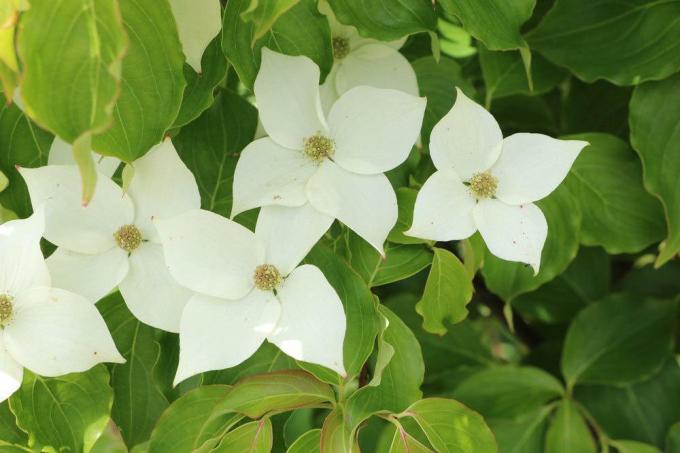
Stone linden, winter linden (Tilia cordata)
The whitish-green flowers only catch the eye on closer inspection. You will definitely head for the blooming tree, because the tiny flowers give off a bewitching scent that arouses curiosity. This magical attraction is followed by bees, bumblebees and butterflies in droves. Therefore, the stone linden is considered to be one of the best bee pastures in the plant kingdom.
- Height: 1500 to 3000 cm
- Location: sunny to partially shaded
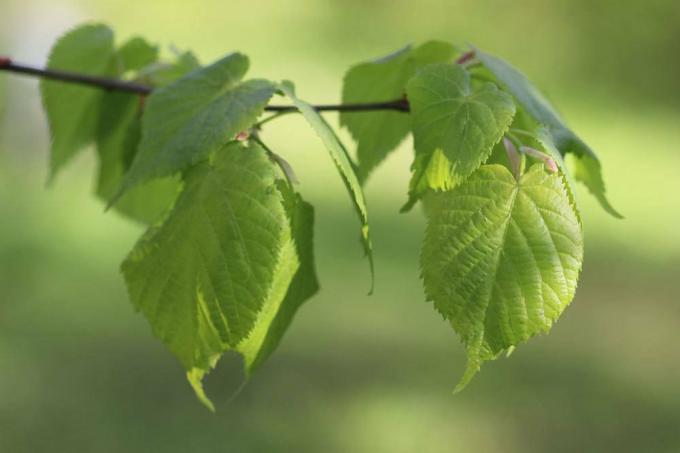
Flower color: yellow
Cucumber Magnolia (Magnolia acuminata)
With yellow flowers in summer, curious glances over the garden fence are inevitable with this magnolia. When the yellowish-green, large flowers open from June, other magnolias have long since finished their floral appearance on the garden stage. The exception owes its name to the cucumber-shaped, green fruits in autumn over brown-yellow leaves.
- Height: 800 to 1200 cm
- Location: sunny and well protected
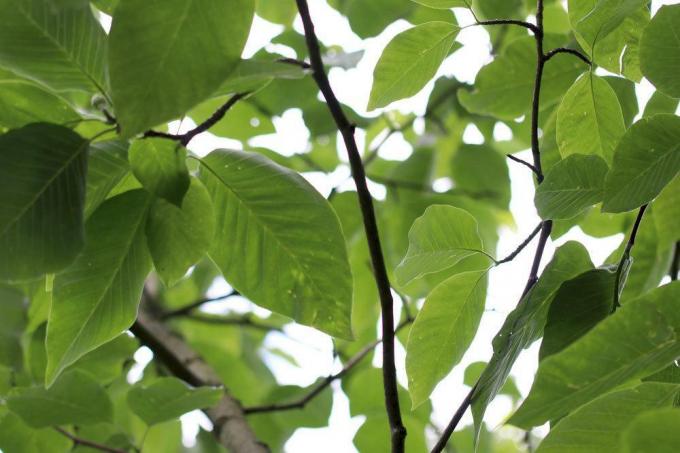
Tip: Summer-flowering trees get their shape and maintenance cut in the period from January to March. This choice of date gives the trees enough time to plant the buds for this year's flower festival.
Flowering period: July
Flower color: pink
Silk tree (Albizia julibrissin)
The pink brush blossoms exude an exotic flair in the summer garden. The Asian silk tree feels right at home in mild winter regions also north of the Alps, so that it is to be found more and more frequently as a result of increasing global warming. The furious flowering time extends from July to August, which is given a magical touch by huge pinnate leaves.
- Height: 600 to 800 cm
- Location: sunny (in the first 5 years with winter protection)
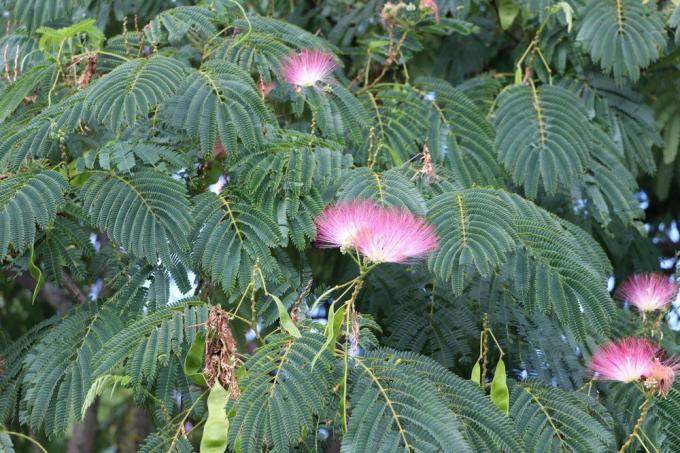
Flowering period: November
Flower color: White
Bodnant winter snowball 'Dawn' (Viburnum x bodnantense)
In mild winter locations, the whitish-pink flowers open as early as November and exude their fragrant magic into April. The deciduous foliage adds another aspect of color by turning red in autumn before falling to the ground.
- Growth height: 250 to 300 cm
- Location: sunny to partially shaded

Flower color: pink
Snow cherry, winter cherry (Prunus subhirtella f. autumnalis)
When the pink blossom festival begins in November, the deciduous leaves have long since changed color and are falling to the ground. This is no obstacle for the snow cherry to immerse the winter garden in a sea of blossoms. If the winter comes with severe frost, the flowering period pauses from the end of December, in order to await a splendid second flowering in March and April.
- Growth height: 350 to 500 cm
- Location: sunny



